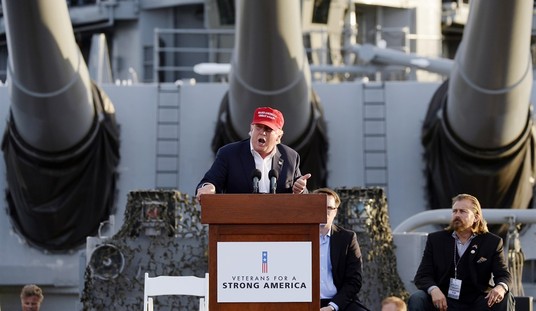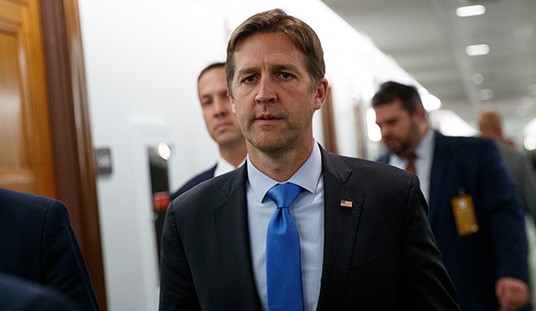
The backstory of Ferguson was that out of the millions of arrests each year only about 100 African-American suspects are shot fatally by white police. And yet we were falsely and ad nauseam told that Michael Brown was proof of an epidemic. There may well be an epidemic of blacks killing blacks, of African-Americans engaging in the knock-out game against non-blacks or flash-mobbing stores. But as far as rare interracial gun violence goes, in 2014 it is more commonly black on white. Ferguson is an anomaly that did not warrant hundreds of reporters who gladly skipped the real dramas of a world on the verge of blowing apart as it had in 1939.
In short, the only reason Ferguson erupted was because the police officer in question was white; had he been black and shot either a white or black suspect, there would have been no civil unrest, no visit by Eric Holder, but instead, liberal calls to ensure due process and not to rush to judgment.
Almost no one believes the myths concocted at the beginning of the Ferguson controversy. That is not to say that we know what happened, only that we most certainly know that what we were told did not happen.
Michael Brown, the “young boy” and “gentle giant” and shy college-bound student, tragically was not simply minding his own business on his way to granny’s as we were told. As in the case of Tawana Brawley, as in the case of the Duke stripper, as in the case of Trayvon Martin, the mythographies finally were unsustainable: Brown had just committed a strong-armed robbery and was lucky that he was not shot by an armed guard or clerk. He appears on the video as a brutal thug, who uses his size to intimidate and, in cowardly fashion, to bully a much smaller clerk. The world of Michael Brown in that store is the world of barbarism, where there is no law and the strong dictate without mercy to the weak as they see fit. And for that matter, the star eyewitness of the street Mr. Johnson, with a criminal past, should have been arrested as an accomplice in strong-arm robbery when he accompanied Mr. Brown into the store — as well as arrested for deliberately filing (another) false witness report.
Brown was walking down the middle of the street under the influence of marijuana and so he was lucky that he was not hit by a car. He struck an officer — no one denies that — which in itself is another felony. He was not shot in the back as the community insisted and still dreams. All that suggests many of the eyewitnesses fabricated stories, the media misled the public, and the race industry likewise serially lied. We are back to the doctored videos, altered transcripts, and fabricated vocabulary of the treatment accorded George Zimmerman or the mythologies at Duke or of the O.J. trial.
It was a hard call whether Missouri Gov. Nixon or Attorney General Eric Holder proved the greater disgrace in their efforts to prejudge the case. The latter of “cowards” and “my people” infamy almost immediately talked up his racial fides among African-Americans while all but damning the police, while the former proved our version of a hapless Ray Nagin, in his jabbering about prosecuting Officer Wilson without an indictment.
So what is left? The predetermined indictment, prosecution, and conviction of Officer Wilson are apparently a necessary sacrifice to ensure calm on the streets and pacify the mob. To further that goal, after the initial myths vanished, community anger will now focus on the fact that the battered cop shot too many times at a charging 6’4” robbery suspect (are six shots too many for someone that large?) and the unfortunate fact that the body of Mr. Brown was left on the street too long. But as in the other myths, these narratives too may soon change.
Americans who watch all this know enough to suspend judgment about guilt or innocence until all the facts have been gathered and adjudicated. But for the time being they have been told to believe, by both activists and media, something that in their own lives they know is quite impossible: namely, that entering a store while under the influence of marijuana, strong-arming the clerk, stealing merchandise, walking down the center of a street, and, when stopped, striking a police officer in the face all should not necessarily illicit a quite dangerous response from an officer. Every American at one time or another has encountered an obnoxious police officer who gratuitously emphasized his authority; and most Americans know enough to keep quiet and take their medicine until the ticket or warning process is over.
The assorted media soon outnumbered the shrinking groups of demonstrators, and prowled the streets desperately looking for some sort of newsworthy incident to confirm their own predetermined narratives. Each time they interviewed a participant in the demonstrations to capture the personal anguish side of the story, they seemed to cut short the dialogue once it became clear that the interviewee had no intention of allowing due process for the officer.
Another strange note: largely white reporters blend into largely African-American crowds, turn on their cameras and sound, often with eyes darting about on those around them, and then try to present a story that is supposedly balanced but also does not bring them physical harm. (Cf. the hasty retreat of the two white protestors who had signs calling for a suspension of judgment until the facts were in). When behind police lines, journalists’ narratives often markedly veered from those when on the barricades. Fairly or not, viewers receive the impression that if reporters were to question the premises of the demonstrations while among the demonstrators, they then would get a quite different reaction from that of questioning police tactics among the police. Their reporting reminds me of journalists in Gaza spinning therapeutic narratives on the understanding that Hamas treats unfavorable news quite differently from the fashion of the Israelis.
We are back to an O.J./Duke Lacrosse/Trayvon landscape, in which larger and mostly unsolvable issues loom — and yet cannot be discussed: the one side silently seethes: “Please, do not commit 50% of the violent crime in America at rates four times your demographic, and, please, stop shooting nearly 7,000 fellow African-Americans a year, to ensure that there is less likelihood to encounter the police — in other words, restore the family, cease the violent and misogynist hero worship, and be wary of government dependence.” And the other side simmers: “Create for us the economic and social conditions in which we have equal opportunity without prejudice and stop the police from inordinately harassing us.” Amid that growing divide, which is now some 60 years old, all the trillions of dollars of the Great Society, Jesse Jackson, Al Sharpton, and an array of “activists,” all the latest criminological and sociopolitical theories, and trillions of man-hours of social work have come apparently to naught.
Another irony is a sort of Sidwell Friends liberalism: the elite censors in politics and the media who with frowns and creased brows lament the lack of diversity and de facto segregation that frame this controversy usually give no evidence that in their own lives that they are committed to living among those of a quite different economic status, sometimes checkered criminal backgrounds, and a different race — as evidenced by where they choose to live, school their children, or recreate.
Yet if our power brokers chose to live in the inner city, to enroll their children in public schools, and to visit local neighborhood establishments, perhaps they could marry their often loud abstract anguish with quiet concrete experience. Instead, we get the impressions that the Michael Browns and Trayvon Martins of America are the sort of fodder that the race industry elite and the white liberal grandees devour for their own respective careerist and psychological purposes. Because of inner-city pathologies and disparities, affirmative action is now perpetual and yet largely benefits those elites who have little in common with those who commit 50% of the nation’s homicides, while privileged liberals understand that if they don’t transmogrify Ferguson, Missouri, into Bull Connor and Lester Maddox, then their own apartheid existence and abstract anguish are called into question.
In the end, our censors in the media and politics find psychological redemption for their own separateness by loudly denouncing in the abstract racism, police excess, and the supposed illiberal nature of whites less sophisticated than themselves.
Amid such mythologies and fantasies, a sense of ennui sets in, a sort of boredom from the acknowledgment that nothing much changes, and nothing much will change, as people continue to self-segregate. In about a year or two we will see another Trayvon Martin or Michael Brown, another set of mythologies, and another Eric Holder intervention.
This is not going to end well, as long as the Sharptons, Jacksons, Shabbazes, and white media magnificoes do not ask self-introspective questions.
The problem is not just that white America is tiring of all this, but that Asian and Hispanic America is too, and will sadly and quietly make the necessary adjustments in their own lives to reflect that dissatisfaction.









Join the conversation as a VIP Member